931 14th St.
14th Floor Museum
In 1929, there was no 14th floor museum; the entire floor was given over to executive offices and the Board Room. Now, in addition to a few offices and departmental space, and of course the Board Room, the 14th floor houses a telephone museum. Originally set up by the Telephone Pioneers
Definition
Telephone Pioneers
According to their mission statement, "The Telecom Pioneers is a network of current and former telecom industry employees and their families who volunteer to address community needs. We represent our companies’ and the industry’s commitment to responsible corporate citizenship."
In 1910, Henry Pope sat at his desk at AT&T and reflected on how the telephone industry had grown since the invention of the telephone 34 years earlier. He thought about the men and women who had contributed to its success, and he wondered where they were and what had happened to them over the years. Then he began to write down their names.
 One year later, with the help of an associate, Charles Truex, and retired inventor Thomas Doolittle, he presented a list to AT&T President Theodore N. Vail. Pope proposed that a society be formed of telephone people with 21 years or more of service —the "pioneers" who had built an invention into an industry.
One year later, with the help of an associate, Charles Truex, and retired inventor Thomas Doolittle, he presented a list to AT&T President Theodore N. Vail. Pope proposed that a society be formed of telephone people with 21 years or more of service —the "pioneers" who had built an invention into an industry.
On November 2, 1911, 244 people (of the original 439 to join the society) attended the first meeting of the Telephone Pioneers of America at the Hotel Somerset in Boston. The signature of Alexander Graham Bell appeared as Pioneer No. 1 on the hotel's register.
At that first meeting, two goals were established: to perpetuate the ideals and traditions of the business; and to promote fellowship. During World War II, a third goal came to the forefront: social service.
Today, the renamed TelecomPioneers association is the world's largest industry-specific volunteer organization dedicated to community service. More information about the Pioneers can be viewed on their website: pioneersvolunteer.org.
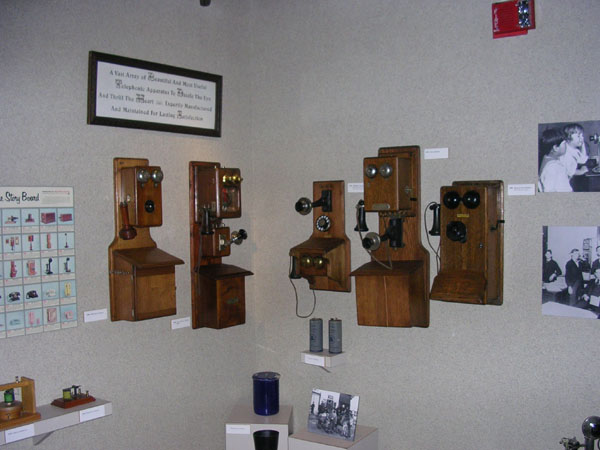 |
There is a large collection of telephones showing the evolution of telephone technology starting with the first “working” telephone; several Magneto crank wooden phones—one with a Blake transmitter invented by Edison; and several Banjo back phones named after the shape of their backboards. |
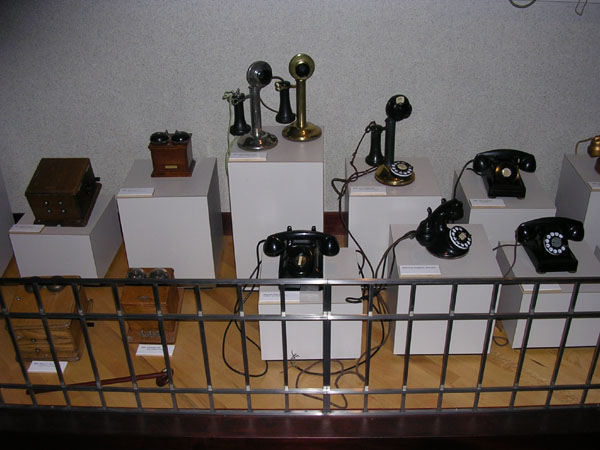 |
Original switches in this building brought dial phones to Denver. (Two examples are in the museum; a candlestick dial phone and a French dial cradle phone made of bakelite, an early plastic.) |
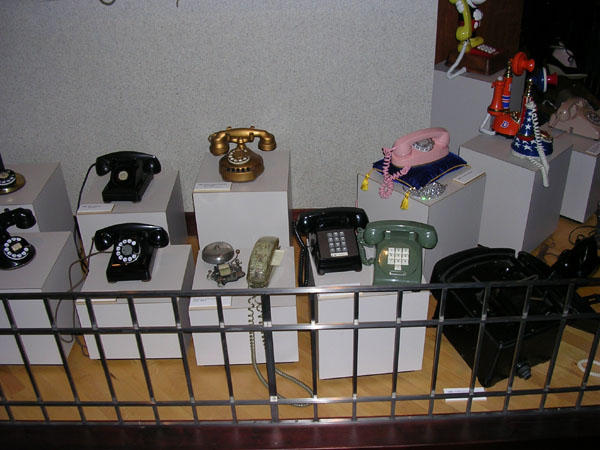 |
A unique working phone was used to test the push-button cascade dial design. Its buttons were too large and women caught their fingernails on the step up between the keys. It failed the test. |
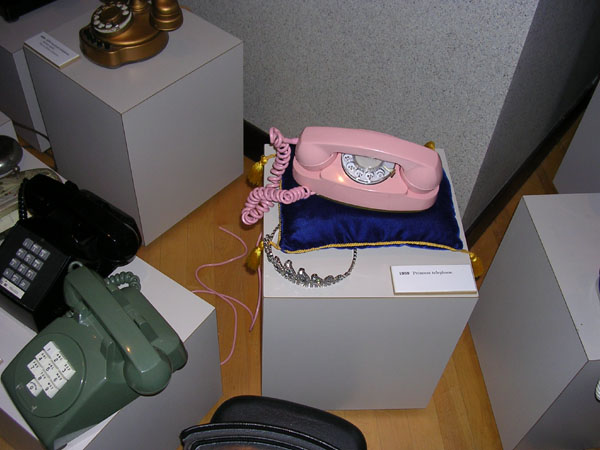 |
The dial Princess Phone® (introduced in 1959) and rhinestone tiara are artifacts from the promotion of this phone by 1958 Miss America, former Miss Colorado, Marilyn VanDerbur. The phone came in six colors with its marketing slogan, “It’s little, it’s lovely, it lights.” In fact it was too light, so after the Denver test market, a steel plate was added to the phone’s base. |
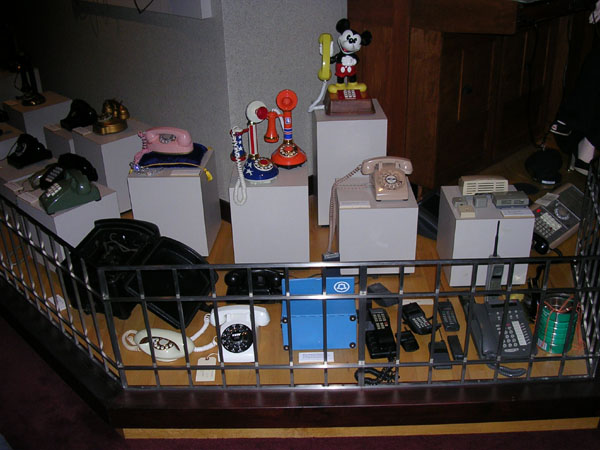 |
A series of cell phones show the evolution of cell phone technology from a phone the size and weight of a brick to a palm phone. |
 |
The last cordboard (a station attended by an operator who plugged in wires to complete calls) in Mountain Bell was removed from service in 1983 in Billings, Montana, and shipped to this museum. Since then it has starred in television programs on all major networks. |
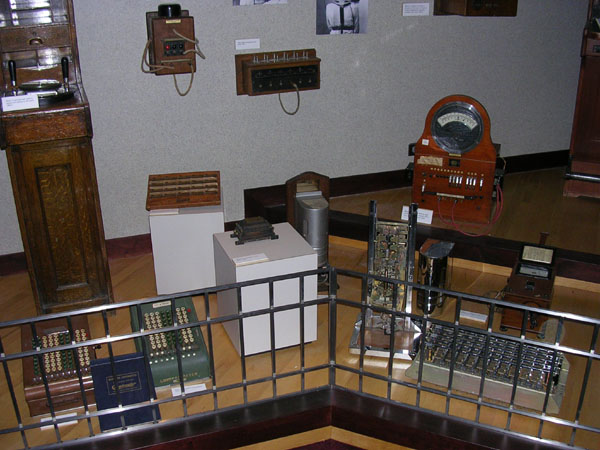 |
Several switches are on display, including the one used to connect phone calls at the building’s opening in 1929. (Click here
 931 Exhibit
How did the switches in the telephone building work? Play the video below to find out!
|
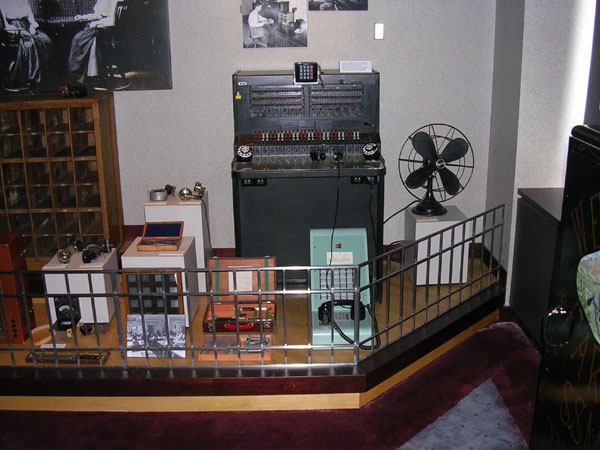 |
President Eisenhower’s summer White House communications system on display enabled the president to talk to any telephone in the world at any time. This little cord board included all necessary technology to receive calls from around the world. |
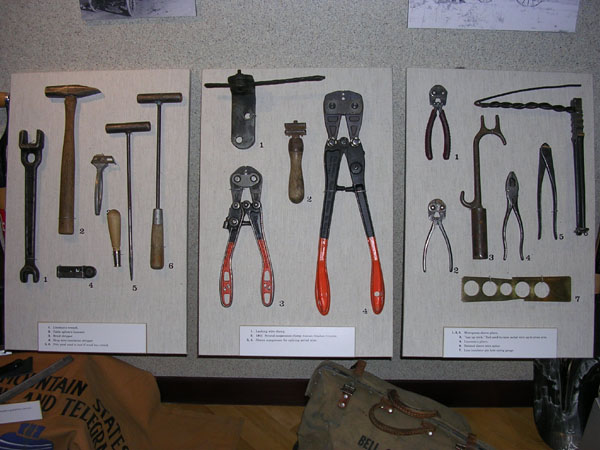 |
The lineman’s tool belt (above, cowboy in panorama) contains all the tools required by a telephone lineman, shown in the image to the left. |
Click here to continue the guided tour up on the 15th floor.
Exhibit Entry | Site History | Local Com History | Architecture | True Murals | Building Tour Basements | Main | Even | Odd | 14th Floor | Museum | 15th Floor
931 14th St.
14th Floor Museum
In 1929, there was no 14th floor museum; the entire floor was given over to executive offices and the Board Room. Now, in addition to a few offices and departmental space, and of course the Board Room, the 14th floor houses a telephone museum. Originally set up by the Telephone Pioneers
Definition
Telephone Pioneers
According to their mission statement, "The Telecom Pioneers is a network of current and former telecom industry employees and their families who volunteer to address community needs. We represent our companies’ and the industry’s commitment to responsible corporate citizenship."
In 1910, Henry Pope sat at his desk at AT&T and reflected on how the telephone industry had grown since the invention of the telephone 34 years earlier. He thought about the men and women who had contributed to its success, and he wondered where they were and what had happened to them over the years. Then he began to write down their names.
 One year later, with the help of an associate, Charles Truex, and retired inventor Thomas Doolittle, he presented a list to AT&T President Theodore N. Vail. Pope proposed that a society be formed of telephone people with 21 years or more of service —the "pioneers" who had built an invention into an industry.
One year later, with the help of an associate, Charles Truex, and retired inventor Thomas Doolittle, he presented a list to AT&T President Theodore N. Vail. Pope proposed that a society be formed of telephone people with 21 years or more of service —the "pioneers" who had built an invention into an industry.
On November 2, 1911, 244 people (of the original 439 to join the society) attended the first meeting of the Telephone Pioneers of America at the Hotel Somerset in Boston. The signature of Alexander Graham Bell appeared as Pioneer No. 1 on the hotel's register.
At that first meeting, two goals were established: to perpetuate the ideals and traditions of the business; and to promote fellowship. During World War II, a third goal came to the forefront: social service.
Today, the renamed TelecomPioneers association is the world's largest industry-specific volunteer organization dedicated to community service. More information about the Pioneers can be viewed on their website: pioneersvolunteer.org.

There is a large collection of telephones showing the evolution of telephone technology starting with the first “working” telephone; several Magneto crank wooden phones—one with a Blake transmitter invented by Edison; and several Banjo back phones named after the shape of their backboards.

Original switches in this building brought dial phones to Denver. (Two examples are in the museum; a candlestick dial phone and a French dial cradle phone made of bakelite, an early plastic.)

A unique working phone was used to test the push-button cascade dial design. Its buttons were too large and women caught their fingernails on the step up between the keys. It failed the test.

The dial Princess Phone® (introduced in 1959) and rhinestone tiara are artifacts from the promotion of this phone by 1958 Miss America, former Miss Colorado, Marilyn VanDerbur. The phone came in six colors with its marketing slogan, “It’s little, it’s lovely, it lights.” In fact it was too light, so after the Denver test market, a steel plate was added to the phone’s base.

A series of cell phones show the evolution of cell phone technology from a phone the size and weight of a brick to a palm phone.

The last cordboard (a station attended by an operator who plugged in wires to complete calls) in Mountain Bell was removed from service in 1983 in Billings, Montana, and shipped to this museum. Since then it has starred in television programs on all major networks.

Several switches are on display, including the one used to connect phone calls at the building’s opening in 1929. (Click here

931 Exhibit
Switching Example
How did the switches in the telephone building work? Play the video below to find out!
So what's going on in the video? The caller (left) lifts the handset to establish the circuit, then dials the digits of the telephone number. The dial sends a series of pulses, or clicks, down the circuit to the switch: one pulse for the number "1," three pulses for the number "3," and so on.
The Central Office switch contains banks of 10-level relays, each representing one of the numbers in a telephone number.
Each pulse from the caller's telephone advances a relay bank by one step. In this demonstration, the caller is dialing 341-5555, so the dial sends three pulses, then four pulses, then one pulse, and so on. The combination of connections establishes the path upon which the call goes through, and the called phone rings (right).

President Eisenhower’s summer White House communications system on display enabled the president to talk to any telephone in the world at any time. This little cord board included all necessary technology to receive calls from around the world.

The lineman’s tool belt contains all the tools required by a telephone lineman, shown in the image above.
Click here to continue the guided tour up on the 15th floor.
back to top
back to 14th Floor
on to 15th Floor
Exhibit Entry | Site History | Local Com History | Architecture | True Murals | Building Tour
Basements | Main | Even | Odd | 14th Floor | Museum | 15th Floor